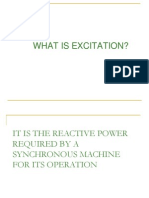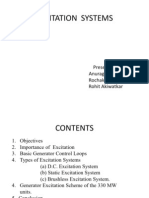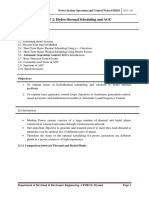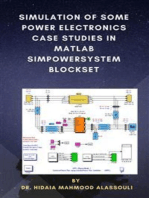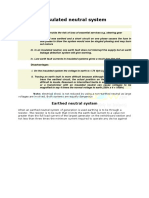Basic Generator Control Loops
Uploaded by
Chinedu EgbusiriBasic Generator Control Loops
Uploaded by
Chinedu EgbusiriSIMULATION OF TWO AREA CONTROL SYSTEM USING SIMULINK
BASIC GENERATOR CONTROL LOOPS
In an interconnected power system, load frequency control (LFC) and automatic voltage regulator (AVR) equipment are installed for each generator. Figure2.1 represents the schematic diagram of the load frequency control (LFC) loop and the automatic voltage regulator (AVR) loop. The controllers are set for a particular operating condition and take care of small changes in load demand to maintain the frequency and voltage magnitude within the specified limits. Small changes in real power are mainly dependent on changes in rotor angle and, thus, the frequency. The reactive power is mainly dependent on the voltage magnitude (i.e., on the generator excitation). The excitation system time constant is much smaller than the prime mover time constant and its transient decay much faster and does not affect the LFC dynamics. Thus, the cross-coupling between the LFC loop and the AVR loop is negligible, and the load frequency and excitation voltage control are analyzed independently.
Figure 2.1 Schematic diagram of LFC and AVR of a synchronous generator
SIMULATION OF TWO AREA CONTROL SYSTEM USING SIMULINK
SIMULATION OF TWO AREA CONTROL SYSTEM USING SIMULINK
3. LOAD FREQUENCY CONTROL
The operation objectives of the LFC are to maintain reasonably uniform frequency, to divide the load between generators, and to control, and to control the tie-line interchange schedules. The change in frequency and tie-line real power are sensed, which is a measure of the change in rotor angle , i.e., the error to be corrected. The error signal, i.e., f and P tie, are amplified, mixed, and transformed into a real power command signal Pv, which is sent to the prime mover to call for an increment in the torque. The prime mover, therefore, brings change in the generator output by an amount P g which will change the values of f and Ptie within the specified tolerance. The first step in the analysis and design of a control system is mathematical modeling of the system. The two most common methods are the transfer function method and the state variable approach. The state variable approach can be applied to the portray linear as well as nonlinear systems. In order to use the transfer function the system must first be linearized. The transfer function models for following components are obtained.
SIMULATION OF TWO AREA CONTROL SYSTEM USING SIMULINK
3. LOAD FREQUENCY CONTROL
The operation objectives of the LFC are to maintain reasonably uniform frequency, to divide the load between generators, and to control, and to control the tie-line interchange schedules. The change in frequency and tie-line real power are sensed, which is a measure of the change in rotor angle , i.e., the error to be corrected. The error signal, i.e., f and P tie, are amplified, mixed, and transformed into a real power command signal Pv, which is sent to the prime mover to call for an increment in the torque. The prime mover, therefore, brings change in the generator output by an amount P g which will change the values of f and Ptie within the specified tolerance. The first step in the analysis and design of a control system is mathematical modeling of the system. The two most common methods are the transfer function method and the state variable approach. The state variable approach can be applied to the portray linear as well as nonlinear systems. In order to use the transfer function the system must first be linearized. The transfer function models for following components are obtained.
3.1 GENERATOR MODEL
One of the essential components of power systems is the three phase ac generator known as synchronous generator or alternator. Synchronous generators have two synchronously rotating fields: one field is produced by the rotor driven at synchronous speed and excited by dc current. The other field is produced in the stator windings by the three-phase armature currents. The dc current for the rotor windings is provided by excitation systems. Today system use ac generators with rotating rectifiers, known as brushless excitation systems. The generator excitation system maintains generator voltage and controls the reactive power flow.
SIMULATION OF TWO AREA CONTROL SYSTEM USING SIMULINK
Pm(s) _
1/2Hs
(s)
Pe(s)
Figure 3.1 Transfer function model for generator model
In a power plant, the size of generators can vary fro 50 MW to 1500 MW.
3.2 LOAD MODEL
The load on a power system consists of a variety of electrical devices. For resistive loads, such as lighting and heating loads, the electrical power is independent of frequency. Motor loads are sensitive to changes in frequency. How sensitive it is to frequency depends on the composite of the speed-load characteristics of all the driven devices. Including the load model in the generator block diagram, results in the block diagram of Figure 3.2.
PL(s)
SIMULATION OF TWO AREA CONTROL SYSTEM USING SIMULINK
Pm(s)
1/(2Hs+D)
(s)
Figure 3.2 Transfer function model for load model
3.3 PRIME MOVER MODEL
The source of mechanical power, commonly known as prime mover, may be hydraulic turbines at waterfalls, steam turbines whose energy comes from the burning of coal, gas, nuclear fuel, and gas turbines. The model of the turbines relates change in mechanical power output Pm to changes in steam valve position Pv. Different types of turbines vary widely in characteristics. The simplest prime mover model for the nonreheat steam turbine can be approximated with a single time constant TT. The time constant TT is in the range of 0.2 to 2.0 seconds.
PV(s)
1/(1+TTs)
Pm(s)
Figure 3.3 block diagram for a simple nonreheat steam turbine
3.4 GOVERNOR MODEL
When the generator electrical load is suddenly increased, the electrical power exceeds the mechanical power input. This power deficiency is supplied by the kinetic energy stored in the
SIMULATION OF TWO AREA CONTROL SYSTEM USING SIMULINK
rotating system. The reduction in kinetic energy causes the turbine speed and, consequently, the generator frequency to fall. The change in speed is sensed by the turbine governor which acts to adjust the turbine input valve to change the mechanical power output to bring the speed to a new steady-state. The earliest governors were the watt governors which sense the speed by means of rotating flyballs and provide mechanical motion in response to speed changes. However, most modern governors use electronic means to sense speed changes. Figure 3.4 shows schematically the essential elements of a conventional Watt governor which consists of the following major parts.
1. Speed governor: The essential parts are centrifugal flyballs driven directly or
through
gearing by the turbine shaft. The mechanism provides upward and downward vertical movements proportional to the change in speed.
2. Linkage Mechanism: These are links for transforming the flyballs movement to the turbine valve through a hydraulic amplifier and providing a feedback from the turbine valve movement.
SIMULATION OF TWO AREA CONTROL SYSTEM USING SIMULINK
Figure 3.4 Speed governing system
3. Hydraulic Amplifier: Very large mechanical forces are needed to operate the steam valve. Therefore, the governor movements are transformed into high power forces via several stages of hydraulic amplifiers. 4. Speed Charger: the speed charger consist of servomotor which can be operated manually or automatically for scheduling load at nominal frequency. By adjusting this set point, a desired load dispatch can be scheduled at nominal frequency.
PL(s)
SIMULATION OF TWO AREA CONTROL SYSTEM USING SIMULINK
_ Pref(s) Pg 1/(1+Tgs) PV 1/(1+TTs) Pm 1/(2Hs+D) (s)
_
Governor Turbine Rotating mass and load
1/R
Figure 3.5 LFC block diagram of an isolated system
SIMULATION OF TWO AREA CONTROL SYSTEM USING SIMULINK
SIMULATION OF TWO AREA CONTROL SYSTEM USING SIMULINK
4. AUTOMATIC GENERATION CONTROL
When the load on the system is increased, the turbine speed drops before the governor can adjust the input of the steam to the new load. As the change in the value of speed diminishes, the error signal becomes smaller and position of the governor falls gets closer to the point required to maintain a constant speed. However the constant speed will not be the set point, and there will be offset. One way to restore the speed or frequency to its nominal value is to add an integrator.
The integral unit monitors the average error over a period of time and will overcome the offset. Because of its ability to return a system to its set point, integral action is known as the rest action. Thus, as the system load change continuously, the generation is adjusted automatically to restore the frequency to the nominal value .This scheme is known as the automatic generation control (AGC).
In an interconnected system consisting of several pools, the role of the automatic generation control (AGC) is to divide the loads among system, station generators so as to achieve maximum economy and correctly control the scheduled interchanges of tie-line power while maintaining a reasonably uniform frequency. During large transient disturbances and emergencies, AGC is bypassed and other emergency controls are applied.
Modern power system network consists of a number of utilities interconnected together & power is exchanged between utilities over tie-lines by which they are connected. Automatic generation control (AGC) plays a very important role in power system as its main role is to maintain the system frequency and tie line flow at their scheduled values during normal period and also when the system is subjected to small step load perturbations. Many investigations in the field of automatic generation control of interconnected power system have been reported over the past few decades.
SIMULATION OF TWO AREA CONTROL SYSTEM USING SIMULINK
4.1 AGC IN A SINGLE AREA SYSTEM
With the primary LFC loop, a change in the system load will result in a steady-state frequency deviation, depending on the governor speed regulation. In order to reduce the frequency deviation to zero, we must provide a reset action. The rest action can be achieved by introducing an integral controller to act on the load reference setting to change the speed set point. The integral controller increases the system type by one which forces the final frequency deviation to zero. The LFC system, with addition the addition of the secondary Figure 4.1. The integral controller gain KI must be adjusted for a satisfactory transient response.
PL(s) _ Pref(s) Pg 1/(1+Tgs) PV 1/(1+TTs) Pm 1/(2Hs+D)
Governor
Turbine
Rotating mass and load
1/R
KI/s
SIMULATION OF TWO AREA CONTROL SYSTEM USING SIMULINK
Figure 4.1 AGC for an isolated power system
4.2 AGC IN MULTIAREA SYSTEM
In many cases, a group of generators are closely coupled internally and swing in unison. Furthermore, the generator turbines tend to have the same response characteristics. Such a group of generators are said be coherent. Then it is possible to let the LFC loop represent the whole system, which is referred to as control area. The AGC of a multiarea system can be realized by studying first the AGC for a two-area system. Consider two areas represented by an equivalent by an equivalent generating unit interconnected by a lossless tie line with reactance Xtie. Each area is represented by a voltage source behind an equivalent reactance as shown in Figure 4.2.
Figure 4.2 Equivalent network for two area power system
During normal operation, the real power transferred over the tie line is given by P12 = |E1| |E2| sin12 X12
SIMULATION OF TWO AREA CONTROL SYSTEM USING SIMULINK
Where X12 = X1+ Xtie+ X2, and 12= 1 - 2. The tie line power deviation then takes on the form P12 = Ps(1 - 2) The tie line power flow appears as a load increase in one area and a load decrease in the other area, depending on the direction of the flow. The direction of the flow. The direction of flow is dictated by phase angle difference; if 1 > 2, the power flows from area 1 to area 2. A block diagram representation for the two-area system with LFC containing only the primary loop is shown in Figure 4.3.
SIMULATION OF TWO AREA CONTROL SYSTEM USING SIMULINK
Figure 4.3 Two area system with primary LFC loop
4.3 TIE-LINE BIAS CONTROL
In the normal operating state, the power system is operated so that the demands of the areas are satisfied at the nominal frequency. A simple control strategy for the normal mode is Keep frequency approximately at nominal value. Maintain the tie-line flow at about schedule. Each area should absorb its own load charges.
SIMULATION OF TWO AREA CONTROL SYSTEM USING SIMULINK
Conventional LFC is based upon tie-line bias control, where each area tends to reduce the area control error (ACE) to zero. The control error for each area tends to consists of linear combination of frequency and tie-line error. ACEi = nj=1 Pij +Ki The area bias Ki determines the amount of interaction during a disturbance in the neighboring areas. An overall satisfactory performance is achieved when K is selected equal to the frequency bias factor of that area, i.e., Bi =1/Ri +Di . Thus, the ACEs for a two area systems are ACE1 = P12 +B1 1 ACE1 = P21 +B2 2 Where P12 and P21 are departures from scheduled interchanges. ACEs are used as actuating signals to activate changes in the reference power set points, and when steady state is reached, P12 and will be zero. The integrator gain constant must be chosen small enough so as not cause the area to go into a chase mode. The block diagram of a simple AGC for two area system is shown in Figure 4.4
SIMULATION OF TWO AREA CONTROL SYSTEM USING SIMULINK
Figure 4.4 AGC block diagram for two area system
You might also like
- Eee-Viii-Power System Operation and Control (10ee82) - Notes PDF81% (21)Eee-Viii-Power System Operation and Control (10ee82) - Notes PDF130 pages
- Simulation of Some Power System, Control System and Power Electronics Case Studies Using Matlab and PowerWorld Simulator ProgramsFrom EverandSimulation of Some Power System, Control System and Power Electronics Case Studies Using Matlab and PowerWorld Simulator ProgramsNo ratings yet
- Automatic Generation Control (AGC) or Automatic Load Frequency Control (ALFC)100% (3)Automatic Generation Control (AGC) or Automatic Load Frequency Control (ALFC)36 pages
- Chapter-3 Load Frequency Control, Control Area Concept100% (1)Chapter-3 Load Frequency Control, Control Area Concept35 pages
- Simulation of Some Power System, Control System and Power Electronics Case Studies Using Matlab and PowerWorld SimulatorFrom EverandSimulation of Some Power System, Control System and Power Electronics Case Studies Using Matlab and PowerWorld SimulatorNo ratings yet
- Chapter Three: Automatic Generation and Voltage Control100% (2)Chapter Three: Automatic Generation and Voltage Control24 pages
- Modeling of Turbine, Generator and Governing System100% (2)Modeling of Turbine, Generator and Governing System21 pages
- (Leon K. Kirchmayer) Economic Operation of Power System88% (8)(Leon K. Kirchmayer) Economic Operation of Power System136 pages
- GovernorStability, Pressure Rise& Speed RiseNo ratings yetGovernorStability, Pressure Rise& Speed Rise5 pages
- Introduction of Automatic Generation Control (Agc) : Chapter-1100% (3)Introduction of Automatic Generation Control (Agc) : Chapter-124 pages
- Methods of Reactive Power Compensation - PPT100% (1)Methods of Reactive Power Compensation - PPT15 pages
- Impacts of Droop and Deadband On Generator Performance and Frequency Control100% (3)Impacts of Droop and Deadband On Generator Performance and Frequency Control5 pages
- Pricing of Transmission Network Usage and Loss AllocationNo ratings yetPricing of Transmission Network Usage and Loss Allocation40 pages
- Unit V Computer Control of Power Systems: 5.3 Data Acquisition and Control (DAS)100% (1)Unit V Computer Control of Power Systems: 5.3 Data Acquisition and Control (DAS)25 pages
- Construction and Operation of Turbogenerator: BY P.Ram Prathap Executive Trainee GMR Group100% (2)Construction and Operation of Turbogenerator: BY P.Ram Prathap Executive Trainee GMR Group19 pages
- 1.0 Automatic Generation Control: Compiled by Shima100% (1)1.0 Automatic Generation Control: Compiled by Shima41 pages
- Simulation of Some Power Electronics Case Studies in Matlab Simpowersystem BlocksetFrom EverandSimulation of Some Power Electronics Case Studies in Matlab Simpowersystem BlocksetNo ratings yet
- Stepper Motors: Stepper Motor vs. Servo Motor100% (1)Stepper Motors: Stepper Motor vs. Servo Motor13 pages
- Induction Heating Equipment Operating ManualNo ratings yetInduction Heating Equipment Operating Manual6 pages
- Problem 3.9 and 3.14 - Khan Muhammad JehangirNo ratings yetProblem 3.9 and 3.14 - Khan Muhammad Jehangir3 pages
- Equations of Motion: Rectangular Coordinates: Today's Objectives: In-Class ActivitiesNo ratings yetEquations of Motion: Rectangular Coordinates: Today's Objectives: In-Class Activities17 pages
- Waha Oil Company: Engineering Specification Air-Cooled Transformer / Rectifier Units For Cathodic Protection SystemsNo ratings yetWaha Oil Company: Engineering Specification Air-Cooled Transformer / Rectifier Units For Cathodic Protection Systems5 pages
- Modelling &simulation of A Three-Phase Electric Traction Induction Motor Using Matlab SimulinkNo ratings yetModelling &simulation of A Three-Phase Electric Traction Induction Motor Using Matlab Simulink7 pages
- StruBIM Cantilever Walls - Reinforced Concrete Cantilever Walls - User ManualNo ratings yetStruBIM Cantilever Walls - Reinforced Concrete Cantilever Walls - User Manual16 pages
- Department of Industrial and Production Engineering Jessore University of Science and TechnologyNo ratings yetDepartment of Industrial and Production Engineering Jessore University of Science and Technology3 pages
- Cambridge International AS and A Level PhysicsNo ratings yetCambridge International AS and A Level Physics1 page
- SC Chapter 17 - Power Supply RegulationNo ratings yetSC Chapter 17 - Power Supply Regulation34 pages
- PP9a - Solutions - Trusses - Method of JointsNo ratings yetPP9a - Solutions - Trusses - Method of Joints8 pages






















